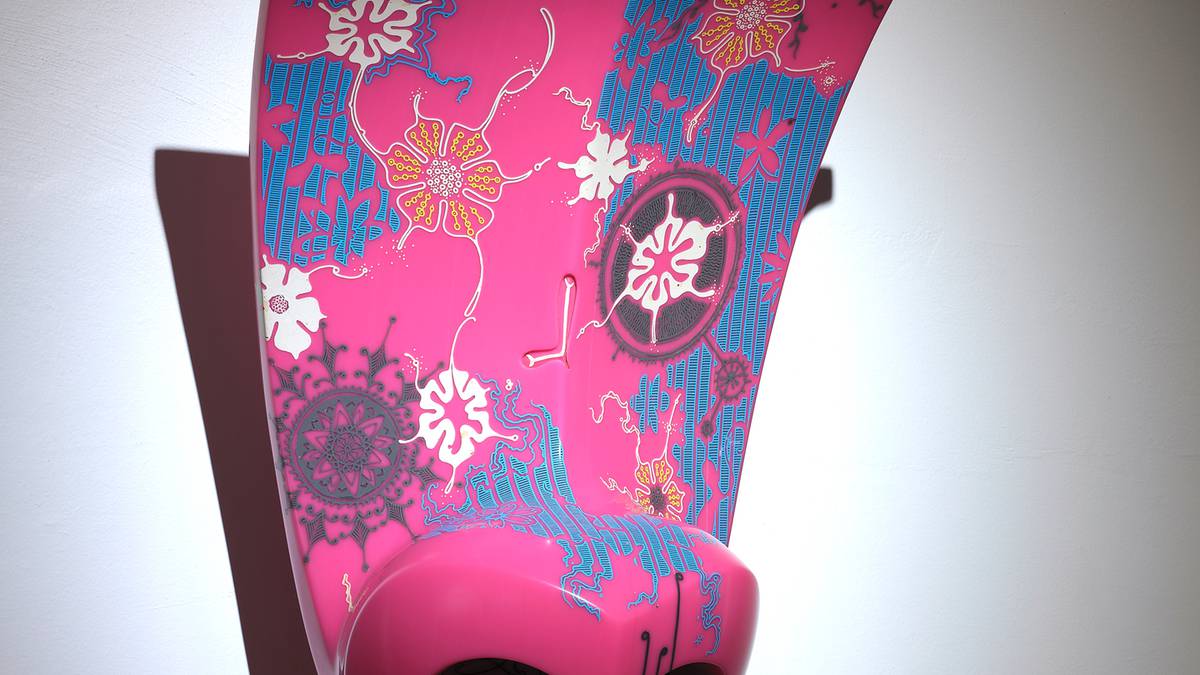Rangi Kipa’s, Flora, 2009, on display at the Wairau Māori Art Gallery.
One of Bob Dylan’s best songs from the 60s, It’s Alright, Ma (I’m Only Bleeding), laments the hollowness of capitalist society.
A stand-out line describes a novelty product he must have seen in a store:
“flesh-coloured Christs that glow in the dark”.
He follows this image with a couplet that’s always haunted me: “It’s easy to see without looking too far/ that not much is really sacred.”
I’m haunted, I guess, by the possibility of the truth of those lines. Looking around today, I’m unsure where “the sacred” exists. I’m not even certain how I would define the word.
Sometimes, though, visiting an art gallery puts me in touch with my longing for a sacred connection.
Two exhibitions at the Whangārei Town Basin remind me that despite our materialist world, the sacred might still be out there.
The first is Laurence Aberhart’s photos of old Northland churches from the early 1980s on display at the Whangārei Art Museum.
The second is the exhibition of three contemporary Māori artists, Rangi Kipa, Lonnie Hutchinson and Kaaterina Kerekere, at the Wairau Māori Art Gallery inside the Hundertwasser building.
Aberhart’s church photos are, for many Northlanders, familiar. You can’t drive too far in Tai Tokerau without seeing a white wooden church on a hill.
/cloudfront-ap-southeast-2.images.arcpublishing.com/nzme/6RIYSHPVHIBYX4S5QHKQOAMTIQ.jpg)
Some of these churches were built by settler communities. Others by Māori families and hapū who had converted to one of the Christian faiths preached by missionaries arriving on these shores.
While these churches have meaning to people of faith, that’s not really what Aberhart’s photos capture or why many of us who are not Christian still hold these wooden churches dear. Without ever having stepped inside them.
There are few more moving sights in Northland than seeing a sunset shining on a small white church, surrounded by farmland, with a backdrop of grey clouds threatening rain. That’s life right there, in all its contrasts and simple beauty.
Aberhart must have been motivated by these types of feelings. But he doesn’t overdo it.
The old 1930s Korona camera he used forced an intimacy of scale. This technical barrier, combined with the time of day that Aberhart chose to photograph the churches, resists the overly dramatic. He didn’t try to turn these small churches into cathedrals or impose a story of struggle between light and darkness.
Instead, Aberhart emphasises the very human scale of these buildings, as if there isn’t room for an all-powerful God in them.
They are modest monuments to the whānau who spend Saturday doing repair jobs on the church, ready for Sunday. It’s the community that’s sacred, with religion the vessel.
The photos are successful as art because they remind you to appreciate again the actual churches. They might inspire you to stop the car and walk up the hill to view a particular church and landscape more closely.
Once there, you won’t fail to think of the people who’ve come before you, living and in death. Churches were often built by hapū on sites that were already tapu (sacred), where ancestors were buried prior to European contact.
The exhibition at Wairau Māori Art Gallery is different in that it’s the artworks themselves where the sacred either resides or doesn’t.
As a Pākehā, I can never claim to access these works’ full depth and meaning. I feel its presence only partially.
Only knowing some te reo, the language elements of Kaaterina Kerekere’s video work were mostly inaccessible. The sound of the mōteatea (a chanted lament by the artist) is still affecting, however, because of what the voice alone communicates.
The visual language used in the video is more universally understood.
The colours are rainbow-hued. Lines and shapes form and dissolve in front of our eyes. They recall traditional whakairo and tukutuku, but I’m also reminded of transit maps for city and train bus routes. Or the circuit board of an electronic device.
Shapes and patterns slide from the top and bottom, left and right, of the picture frame, forming temporary images of a whare, for example.
The movement is fascinating to sit and observe. Nothing is permanent, but it’s all part of the greater whole. Which is surely the point.
For Kerekere, it’s important to maintain a connection to her papakainga (homeland) and whānau. What’s sacred is what connects the mortal individual to a lasting culture and its wisdom. Losing this connection is a source of sadness.
Rangi Kipa’s piece, Flora, I was very taken with. Firstly, there’s the startling impact of the material, a plastic product called Staron. In this case, bold fluoro pink.
The moulded form echoes the traditional parata (figurehead) from the prow of a waka tiwai (light canoe).
The large forehead of the figure leans dramatically into the gallery space. It’s as if the rest of the waka will follow it, materialising from out of the gallery wall. There’s enormous latent energy in the piece.
Overlaying the sculptured shape is Kipa’s idiosyncratic graphic design.
It’s all strikingly modern yet still rooted in tradition and a living culture.
Kipa’s work confirms the nearby statement on the gallery wall that “symbols can offer us an access point or a way to interpret things we don’t understand”.
Or to say something similar: an artwork can convey what we intuitively feel but can’t express adequately in words.
For that reason, I can only suggest you visit these two Whangārei art exhibitions yourself. And decide whether, contrary to Dylan, the sacred can still be found in the world.




